Description
This report examines and compares the budgets, staffing levels, organizational structure composition, and projections for future changes in budgets, staffing and structure at a broad spectrum of human resources (HR) departments of power and utilities companies based in the US and Canada. Data in the report compares HR staffing levels to total company headcounts, and we develop an HR staffing model framework which enables readers to compare their own HR staffing levels to industry-wide metrics.
While many organizations have mistakenly viewed HR departments as a cost center, forward-thinking companies properly value human resources as a strategic partner that can provide a competitive advantage in the marketplace. HR organizations can improve a company’s bottom-line performance through their knowledge of how human capital affects organizational success. HR leaders are catalysts for corporate decision making that underlies staffing assessments and projections for future labor needs to help meet business demand, minimizes organizations’ liability and risk exposure related to safety and employment practices, and strengthen employee-employer relationships.
The role of the human resources function is growing in strategic importance and value given a number of factors in the marketplace, including:
- a quickening pace of regulatory and policy changes governing employment in the US, Canada and elsewhere around the globe,
- aging populations in key markets, which pressures companies to continuously recruit, develop and retain new talent,
- an increasingly litigious culture which leads to greater labor risk exposure, and
- increased merger, acquisition, and integration activity which drives great organizational change.
Energy Decisions Group developed this report to examine and compare the budgets and spending practices, staffing levels, organizational structure composition, reporting relationships, and projections for future changes in budgets, staffing and structure of a broad spectrum of power and utilities companies’ human resources departments. This report examines numerous related issues, such as annual budget data, including budget breakdowns into major spending categories; department staffing metrics and staffing breakdowns by seniority level; and staffing benchmarks to enable comparative analyses by company size and other factors.
Data and Insights Included in This Report
- Human resources department budgets
- Human resources budget outsourcing data
- Projections for changes to HR budgets in the coming years, including factors driving those changes
- HR staffing headcounts (internal employees and contract workers) broken down by seniority level
- Trends and analysis of companies’ future plans for staffing in the next few years, including factors driving changes to HR headcounts
- Analysis of HR organizational structures (stand-alone departments vs. multi-functional departments which include other functions, such as risk management, legal, office management, facilities management, real estate, enterprise records management, etc.)
- Comparisons of centralized, decentralized and matrix organizational structures
- Reporting relationships to executive management
- Plans for re-structuring HR departments in the next few years
Why Buy This Report
- Benchmark human resources budgets and spending practices at other power & utilities companies
- Compare your department’s staffing resources to those of other companies
- Right-size your department’s staffing levels
- Make the case to management for additional budget and staffing resources
- Understand how organizational structure supports or hinders business performance
- Inform decisions about departmental organization and reorganization
Report Contents:
Executive Summary
Summarizes the key findings of our research and develops implications and recommendations
Analysis of Companies Analyzed and Executives Consulted in This Study
Provides summary information and insights about the companies that we examine in this report and the executives who contributed to this research.
Human Resources Budget Allocations and Analysis
Includes analysis of human resources budgets, outsourcing, projections for future spending changes, and related trends at benchmarked companies.
Human Resources Organizational Structure Insights and Analysis
Delves into the details of companies’ HR organizational structures, including analysis of centralized, decentralized and matrix approaches and the advantages/disadvantages of each; assessments of reporting relationships; and companies’ plans for organizational restructuring in the next few years.
Human Resources Staffing Levels and Analysis
Includes detailed examinations of HR staffing levels, including breakdowns of headcounts (as measured in full-time equivalents, or FTEs) at various seniority levels, as well as break-downs of internal company employees versus contracted staffers. Includes analysis of the reporting relationships at the senior-most levels, including the titles and roles of the top executives that oversee human resources and the executives to whom they report, and includes executives’ insights and recommendations on these top-line reporting relationships.
PURCHASING OPTIONS
Credit Card: Pay by credit card through the secure checkout process on our website.
Invoice / Purchase Order: To pay by invoice (with payment by check, wire transfer or automatic bank check/ACH) with or without a purchase order, please contact us by email at client.services@energydecisionsgroup.com. Or, you can submit your request on the “Inquire Before Buying” form on this product page, and we will contact you to finalize your purchase.
Have questions about this report? Want to learn more before you buy? Contact our account management team:
- Email us directly at client.services@energydecisionsgroup.com
- Or, submit your question(s) below and we will be in touch with you shortly.
Complete this form to download a report summary (PDF) containing a table of contents and other useful details to help you further evaluate this report.



